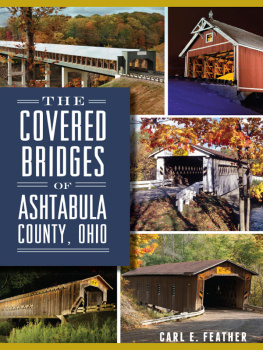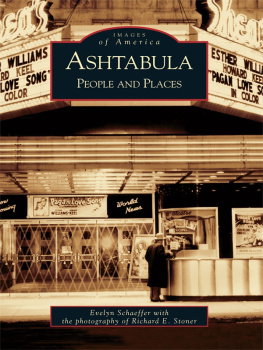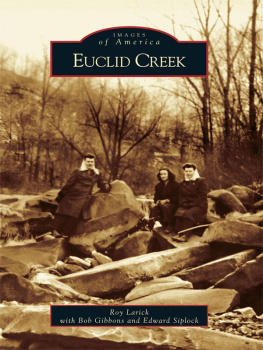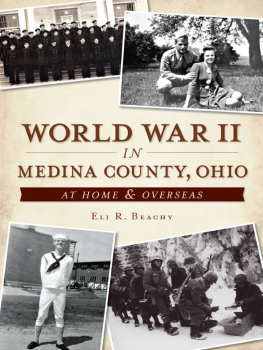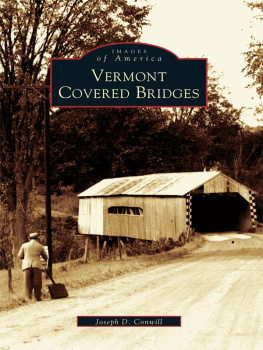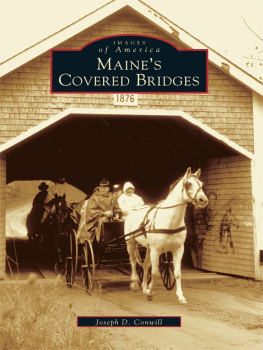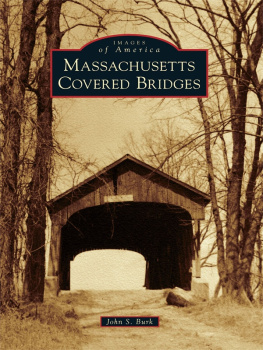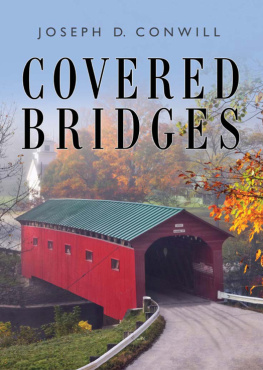
Published by The History Press
Charleston, SC 29403
www.historypress.net
Copyright 2014 by Carl E. Feather
All rights reserved
Cover images by Carl E. Feather.
First published 2014
e-book edition 2014
ISBN 978.1.62584.745.4
Library of Congress Cataloging-in-Publication Data
Feather, Carl E.
The covered bridges of Ashtabula County / Carl E. Feather.
pages cm
Includes bibliographical references and index.
print edition ISBN 978-1-62619-261-4
1. Covered bridges--Ohio--Ashtabula County--History. 2. Ashtabula County (Ohio)--History. I. Title.
TG25.A8F43 2014
388.132--dc23
2013046334
Notice: The information in this book is true and complete to the best of our knowledge. It is offered without guarantee on the part of the author or The History Press. The author and The History Press disclaim all liability in connection with the use of this book.
All rights reserved. No part of this book may be reproduced or transmitted in any form whatsoever without prior written permission from the publisher except in the case of brief quotations embodied in critical articles and reviews.
To my father, Carl J. Feather, my bridge to the past;
To my son, Aaron E. Feather, and my grandson, Mason L. Feather, my bridges to the future.
CONTENTS
ACKNOWLEDGEMENTS
Ashtabula County historian Alice Bliss did a superb job of researching all of the countys covered bridges and serializing her work in Ashtabula County newspapers in the late 1960s. Walter Jack, a newspaperman and photographer, documented in words and images the covered bridges of both Ashtabula (Ohio) and Erie (Pennsylvania) Counties, even as they were disappearing from the scene in the 1930s and 1940s. More recently, Dennis Osborn painstakingly researched both the byway and railroad covered bridges that have received World Guide to Covered Bridges numbers. Their research provided the starting point for my work of tracking down more details and stories while updating the state of covered bridges in Ashtabula County during the past fifty years.
Norma Waters of the Jefferson Historical Society has spent thousands of hours harvesting tidbits from the pages of nineteenth-century Ashtabula County newspapers. On many occasions, as I attempted to complete the half-worked puzzles left behind by other writers, one of Normas purple cards mentioning a bridge or an event provided a missing piece.
The Olin Museum of Covered Bridges provided several photographs for this book, as did Dean Luce of North Kingsville, whose late father, Edward M. Ned Luce, was county road supervisor and engineer. The records of the Ashtabula County Covered Bridge Festival are on file in the Jefferson Historical Societys research library, and they provided photographs of several forgotten crossings. The Ashtabula County Engineers Office also opened its files of documentation, newspaper clippings and images for this work.
Karen Rang, the granddaughter of Walter Jack, graciously allowed contact prints to be made from his original camera negatives from 1930 to 1950, thereby providing readers with a fresh look at old bridges.
Todd Clark of Cincinnati, a collector of covered bridge photographs, kindly supplied images of several extinct bridges from more than a century ago. Todds collection is amazing, exceeded only by his willingness to share his trove with other historians.
The Internet is a wonderful research tool, and I am especially grateful for www.lostbridges.org, which is the work of New Hampshire resident Bill Caswell. Also, a tip of the hat goes to Dale J. Travis (dalejtravis.com) and his online lists of covered bridges and round barns, as well as the Ohio Historic Bridge Association (oldohiobridges.com).
Greg Dumais, my commissioning editor, and the rest of The History Press staff have been a pleasure to work with. I thank them for helping me bring this long-latent work to light.
Finally, an author is always indebted to the patience of his family whenever a work is in progress. To my parents, son and grandson, I say thank you for giving me the space and understanding that allowed me to complete this work. And to my wife, Amanda, I give special gratitude for her patience and willingness to give me the space to work and her professional editing skills, as well as giving me the confidence to tackle the project. Thank you for being my best friend and copy editor.
INTRODUCTION
Snow has been falling on the rural township all afternoon, yet my subcompact cars tires create the first set of tracks in it. The temperature is fifteen degrees, and the parting clouds suggest even colder temperatures are descending like the snow. I pull off the roadonto what I trust is a berm and not a ditchand prepare to work.
The glow of a flat-screen television pours from the living room windows of a McMansion high above the creek bed. The yelps of a dog, perhaps a coyote, echo down the valley. The light is fading quickly. By the time I position my tripod, double-check the focus on my lens and verify the wireless connections, the environment will have changed dramatically. In that darkness peculiar to the rural landscape, the only reality to my camera will be what I illuminate with my strobes.
Why have I chosen this night, this cold, this snow in which to document something that has been here for more than a century and, fire and flood aside, will remain come June? The answer is in my obsession with these structureswooden time tunnels, as I am inclined to call them. They have been my neighbors since my parents moved to this county more than fifty-five years ago, although some have faded from the landscape in that time. Taking that lesson from the past, I photograph those that remain, knowing that nothing lasts forever.
Having grown tired of producing sunny 16 images, I turned in 2011 to photographing the countys covered bridges at night, using the selective nighttime lighting techniques mastered by O. Winston Link. Since starting this project, I have become much more intimate with the details of Ashtabula Countys covered bridges. Nighttime photography forces me to study each bridge ahead of time and decide what features will be illuminated, and thus emphasized, and which will receive only a nod or total disregard. As a result, I have gained an even greater respect for the workmanship of these structures and the men who built them using only basic tools and rivulets of sweat.
Time thus spent in the presence of these functional monuments convinced me that each one possesses a personality and a story. And that is what this book is aboutnot a mere rehashing of construction dates and measurements but rather portraits of these structures and a tribute to their mostly anonymous builders. The countys twelve historical covered bridges are particularly worthy of this honor. They are the only surviving offspring of a romance between a heavily timbered landscape and a race determined to subdue it. We are the blessed heirs of that union, benefactors to a rich heritage bequeathed by displaced New Englanders whose communities are but long shadows cast by their hometowns to the east by hopes sunrise: Windsor, Andover, New Lyme, Colebrook and Dorset. Town squares, town halls, Congregational churches and covered bridgestheir legacy lives on in name and wood.
At least forty-eight wood-truss bridges once stood on the highways of Ashtabula County. Only twelve remain. The future will never give us more of the past than what we hold today, and we must live each day with that reality. Yes, we can and have constructed new timber bridges, and this volume tells their stories as well. But their timbers sprouted and grew in soil far from the rivers they cross, and their trusses were birthed with cranes rather than groans and grind. The historical bridges are treasures that no amount of money can buy, for while we cannot purchase the past, we can honor what is left of it.
Next page
